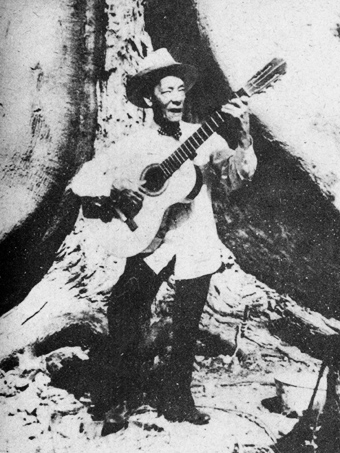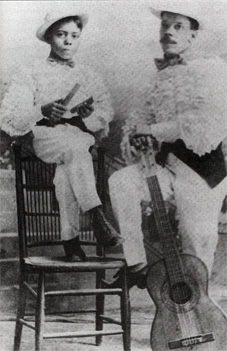
シンド・ガライ
Sindo Garay

☆ シンド・ガライ(Antonio Gumersindo Garay García、サンティアゴ・デ・クーバ、1867年4月12日 - ハバナ、1968年7月17日)は、キューバのトロバ音楽家である。ペペ・サンチェスに師事した。ガライはトロバの四大巨頭の一人である。スペインとアラ ワカの血を引く。
| Sindo Garay (born
Antonio Gumersindo Garay García; Santiago de Cuba, 12 April 1867 –
Havana, 17 July 1968) was a Cuban trova musician. He was taught by Pepe
Sánchez. Garay was one of the four greats of the trova. He was of
Spanish and Arawakan descent. Life & work Garay was the most outstanding composer of trova songs, and his best have been sung and recorded many times. Perla marina, Adios a La Habana, Mujer bayamesa, El huracan y la palma, Guarina and many others are now part of Cuba's heritage. Garay was also musically illiterate – in fact, he only taught himself the alphabet at 16 – but in his case not only were scores transcribed by others, but there are recordings as well.  Guarionex and Sindo Garay, 1906 For a long period he sang in a duo with his eldest son Guarionex; he had two other sons and a daughter, and gave them all Indigenous names. In the 1890s Garay got involved in the Cuban War of Independence, and decided a stay in Hispaniola (Haiti and Dominican Republic) would be a good idea. It was, and he came back with a wife. Garay settled in Havana in 1906, and in 1926 joined Rita Montaner and others to visit Paris, spending three months there singing his songs. He broadcast on radio, made recordings and survived into modern times. He used to say "Not many men have shaken hands with both Jose Marti and Fidel Castro!" Carlos Puebla, whose life spanned the old and the new trova, told a good joke about him: "Sindo celebrated his 100th birthday several times – in fact, whenever he was short of money!"[1][2] References Sublette, Ned 2004. Cuba and its music: from the first drums to the mambo. Chicago. p. 298 de Leon, Carmela 1990. Sindo Garay: memorias de un trovador. La Habana. Garay's life story as told in his nineties; includes a 16-page appendix listing his compositions. |
シンド・ガライ(Antonio Gumersindo Garay
García、サンティアゴ・デ・クーバ、1867年4月12日 -
ハバナ、1968年7月17日)は、キューバのトロバ音楽家である。ペペ・サンチェスに師事した。ガライはトロバの四大巨頭の一人である。スペインとアラ
ワカの血を引く。 生涯と作品 ガライはトローバの歌の最も優れた作曲家であり、その代表作は何度も歌われ、録音されている。Perla marina、Adios a La Habana、Mujer bayamesa、El huracan y la palma、Guarina、その他多くの曲は、今やキューバの遺産の一部となっている。ガレイは音楽的な文盲でもあった-実際、彼は16歳の時にアル ファベットを独学で学んだだけだった-が、彼の場合、楽譜が他の人によって書き写されただけでなく、録音もある。  グアリオネックスとシンド・ガライ、1906年 長い間、彼は長男のグアリオネックスとデュオで歌っていたが、他に2人の息子と1人の娘がおり、全員に先住民の名前をつけていた。 1890年代、ガレイはキューバ独立戦争に巻き込まれ、イスパニョーラ(ハイチとドミニカ共和国)に滞在することを決めた。そして妻を連れて帰国した。ガ レイは1906年にハバナに定住し、1926年にはリタ・モンタネールらとパリを訪れ、そこで3ヶ月間自分の歌を歌った。彼はラジオで放送し、レコーディ ングを行い、現代まで生き残った。彼はよく 「ホセ・マルティとフィデル・カストロの両方と握手した男はそうそういない!」と言っていた。旧トロバと新トロバにまたがる人生を送ったカルロス・プエブ ラは、彼についていいジョークを言った: 「シンドは何度も100歳の誕生日を祝った。実際、金がないときはいつでもだ!」[1][2]。 参考文献 Sublette, Ned 2004. Cuba and its music: from the first drums to the mambo. Chicago. p. 298 de Leon, Carmela 1990. Sindo Garay: memorias de un trovador. La Habana. ラ・ハバナ。90歳を過ぎたガライの半生を綴る。 |
リ ンク
文 献
そ の他の情報
Copyleft, CC, Mitzub'ixi Quq Chi'j, 1996-2099
☆
 ☆
☆